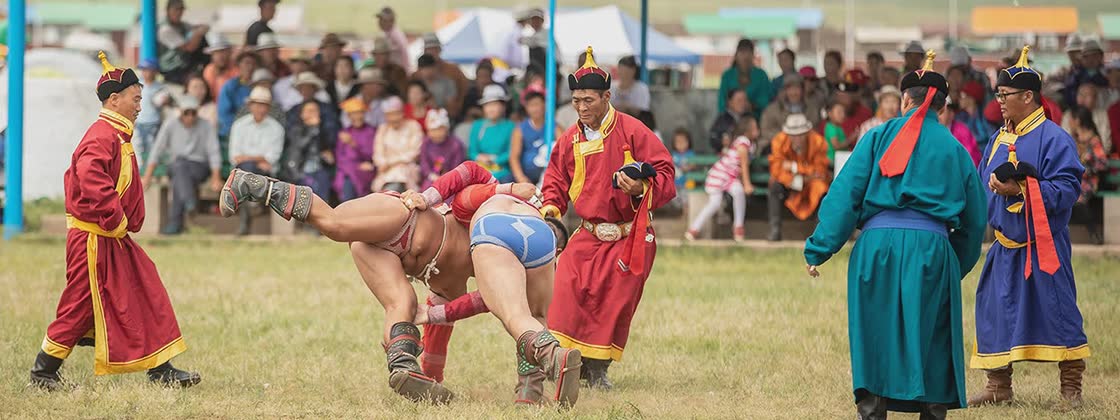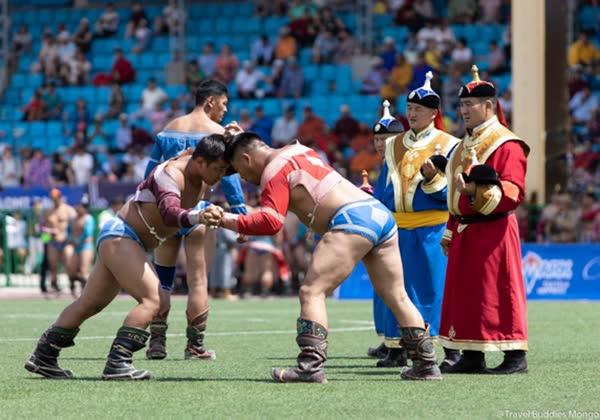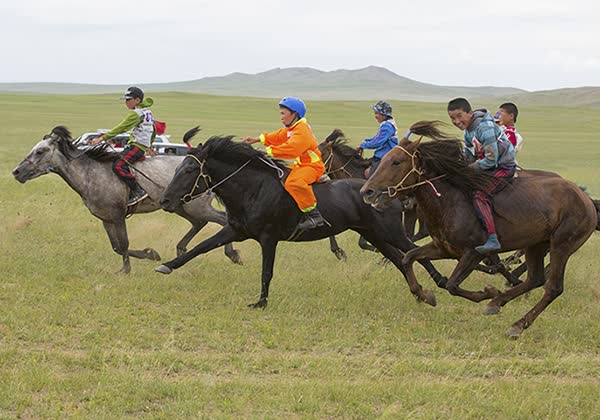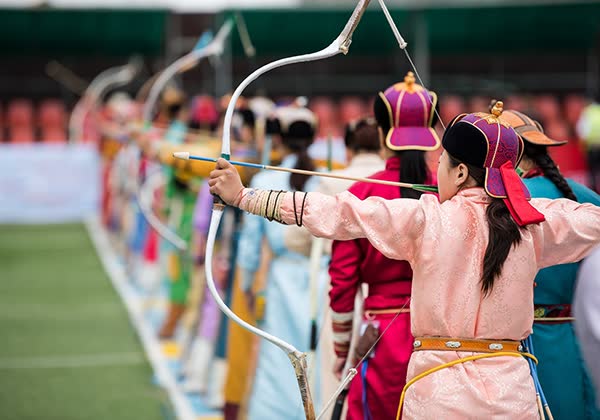The Naadam Festival
ABOUT NAADAM FESTIVAL
The Naadam Festival is one of the most significant and widely celebrated traditional events in Mongolia. It showcases the "Three Manly Games" of Mongolian culture, which are wrestling, horse racing, and archery. Here's some information about the Naadam Festival:

THE THREE GAMES OF MEN

- Cultural Significance: Naadam is deeply rooted in Mongolian history and reflects the country's nomadic heritage. It is a celebration of the "Three Manly Games" that were practiced by warriors and herders throughout Mongolia's history. The festival is an occasion to honor and showcase the physical prowess, skill, and traditional values of Mongolian culture.
- Timing and Location: The Naadam Festival takes place annually from July 11th to 13th across Mongolia, with the largest and most renowned event occurring in the capital city, Ulaanbaatar. The festival is also celebrated in various provinces and local communities throughout the country.
- Wrestling: Wrestling is the most prominent and popular event of the Naadam Festival. Men of all ages, dressed in traditional Mongolian attire, compete in a single-elimination tournament. The wrestling matches are intense and display a mix of strength, technique, and traditional rituals.

- Horse Racing: Horse racing is another highlight of the Naadam Festival. It features long-distance races that can range from 15 to 30 kilometers, depending on the age of the horses. Skilled young jockeys ride the horses, showcasing their equestrian abilities. The races are accompanied by traditional songs and cheering from spectators.
- Archery: Archery competitions are an integral part of the Naadam Festival. Both men and women participate in the archery events, displaying their accuracy and skill in hitting targets from a specified distance. Traditional bows and arrows are used, and the archers often wear colorful traditional costumes.
- Cultural Performances: In addition to the main sporting events, the Naadam Festival also features cultural performances, including traditional music, dance, and singing. These performances add to the festive atmosphere and provide an opportunity to experience the rich cultural heritage of Mongolia.

- Additional Activities: Alongside the three main games, other activities such as ankle bone shooting, traditional clothing showcases, and traditional food and crafts markets can be enjoyed during the Naadam Festival.
Attending the Naadam Festival offers a unique opportunity to immerse yourself in Mongolian culture, witness thrilling sporting competitions, and experience the warmth and hospitality of the local people. It's important to note that the festival attracts large crowds, so planning ahead and arranging accommodations and transportation in advance is advisable.
If you plan to attend the Naadam Festival, be sure to check the exact dates, locations, and any updates or changes to the festival schedule to ensure a memorable and enjoyable experience.
Enjoy your time at the Naadam Festival and celebrate the rich traditions of Mongolia!
The Naadam Festival: A Detailed History
Naadam is Mongolia’s most famous traditional festival, deeply rooted in the country’s nomadic culture and history. Often referred to as “Eriin Gurvan Naadam” (The Three Manly Games), it features three main sports: wrestling, horse racing, and archery. These competitions date back over a thousand years and reflect Mongolia’s warrior traditions, particularly from the era of Genghis Khan and the Mongol Empire.
Origins of Naadam
Ancient Beginnings
Naadam’s origins trace back to the early nomadic tribes of Mongolia, who held competitions in physical strength, endurance, and combat skills. These contests were essential for preparing warriors for battle.
During the 13th century, under Genghis Khan, these games became even more significant as the Mongols built one of the largest empires in history. Warriors showcased their abilities in wrestling, archery, and horseback riding—skills that were crucial for Mongol cavalry.
Religious and Cultural Influences
During the 17th and 18th centuries, when Mongolia was under the influence of the Qing Dynasty and Tibetan Buddhism, Naadam took on a more ceremonial and religious character. Monasteries often organized Naadam games as part of major religious celebrations, incorporating Buddhist rituals and blessings.
Naadam in Modern History
1921: Mongolia’s Independence and Naadam’s Nationalization
After Mongolia declared independence from China in 1921, the Naadam Festival was officially recognized as a national holiday. It was used to celebrate the success of the Mongolian People’s Revolution and the establishment of Mongolia as a socialist republic.
During the communist era (1924–1990), Naadam was transformed into a state-controlled event. The festival showcased national unity, military strength, and athleticism, often featuring elaborate parades, political speeches, and performances.
Post-Communism Era (1990–Present)
After Mongolia transitioned to democracy in 1990, Naadam regained its traditional essence while maintaining its status as a national holiday. Today, it is the most significant cultural event in Mongolia, attracting both locals and international tourists.
Naadam Festival Today
The main Naadam Festival is held every year from July 11 to 13 in Ulaanbaatar, the capital of Mongolia. However, smaller versions of the festival occur in different provinces and rural areas throughout the summer.
The festival opens with a grand ceremony at the National Sports Stadium, featuring:
• Traditional Mongolian music and dance
• Horseback parades
• Military displays
• Speeches from government officials
The Three Main Competitions
1. Wrestling (Bökh)
• 512 or more wrestlers compete in a single-elimination tournament.
• There are no weight classes, and the only rule is that the opponent’s body (besides hands and feet) must touch the ground to lose.
• The winner earns the prestigious title of “Arslan” (Lion).
2. Horse Racing
• Unlike Western-style horse racing, Naadam focuses on long-distance endurance races (10-30 km).
• Riders are mostly children (5-13 years old) due to their lightweight.
• Horses, not jockeys, are awarded titles based on their placement in the race.
3. Archery
• Both men and women compete, using traditional Mongolian bows.
• Targets are small cylindrical objects called “surs,” placed at long distances (60-75 meters for men and 50-60 meters for women).
Other Traditional Games
• Shagai (Ankle Bone Shooting): A precision game using sheep anklebones as targets.
• Knucklebone Flicking: Another popular sport based on accuracy and skill.
Cultural and Global Significance
• In 2010, UNESCO recognized Naadam as an Intangible Cultural Heritage of Humanity.
• The festival is a powerful symbol of Mongolian identity and nomadic heritage.
• Naadam also serves as a social gathering where families and friends come together to celebrate.
Conclusion
Naadam is more than just a sporting event—it is a celebration of Mongolian history, national pride, and traditional culture. From its roots in the Mongol Empire to its current status as Mongolia’s largest festival, Naadam remains a testament to the country’s deep connection to its nomadic warrior past.